|

Creation
of the Tule Ponds
Historic Creation and Uses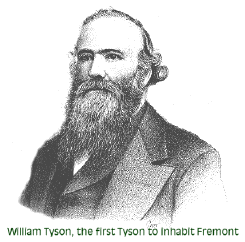
The original Tule pond was created by a geologic event that occurred
in the early 1800's. Rainwater from storms filled the depression
to create the lagoon that bordered the properties of Simeon
Stivers, William Tyson, M. J. Overraker, and Joseph Nicholls in 1878.
The lagoon remained intact for over one hundred years until the project
to create the three new ponds began. Other water bodies, such as
Stivers Lagoon, have changed during the past forty years due to urbanization.
Innovative New Wetlands to Clean Water and
Improve Natural Habitat
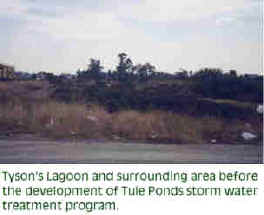
Due to urbanization of the Fremont area a small
patch of wild undeveloped land, located just east of the Fremont
BART station, receives the run off of approximately five hundred acres.
As the water runs off the streets, grass, and dirt in this area it can
become polluted with motor oil, pesticides, herbicides, and fertilizer
before running into the pond. In the early 90's, Alameda County Flood
Control District and the City of Fremont worked on creating a natural water
filtering system, using previous research on the D.U.S.T.
Marsh, located in Coyote Hills. The water is treated naturally
using three ponds that contain several islands to help enhance the value
of the habitat for wildlife.
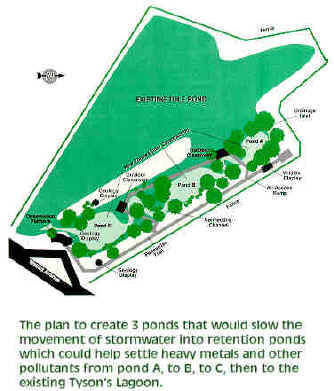 The
water treatment ponds function on the slowing of the water to allow suspended
particles to drop out of the solution. This causes the water to become
less of a potential hazard later in the bay and even the ocean. The
suspended particles range from heavy metals; such as copper (Cu), Lead
(Pb) and Zinc (Zn), to simple things like soil. The heavy metals
can cause fish deaths and algae blooms that can harm the water's environment
for all living things, including making the water unusable for human recreation.
The soil can prevent the penetration of sunlight to the underwater organisms
that use the sunlight to produce nutrients necessary for the organisms
survival. Fertilizers will cause large growths of water plants which
can reduce the necessary amounts of nutrients to fish and other water organisms.
Motor oil will coat fish gills and kill the fish when it cannot breathe,
and it will coat birds wings and make them too heavy to fly away when a
predator is seen. These materials are hazardous to the animals both
in and out of the water as well as the plants in the surrounding waterway. The
water treatment ponds function on the slowing of the water to allow suspended
particles to drop out of the solution. This causes the water to become
less of a potential hazard later in the bay and even the ocean. The
suspended particles range from heavy metals; such as copper (Cu), Lead
(Pb) and Zinc (Zn), to simple things like soil. The heavy metals
can cause fish deaths and algae blooms that can harm the water's environment
for all living things, including making the water unusable for human recreation.
The soil can prevent the penetration of sunlight to the underwater organisms
that use the sunlight to produce nutrients necessary for the organisms
survival. Fertilizers will cause large growths of water plants which
can reduce the necessary amounts of nutrients to fish and other water organisms.
Motor oil will coat fish gills and kill the fish when it cannot breathe,
and it will coat birds wings and make them too heavy to fly away when a
predator is seen. These materials are hazardous to the animals both
in and out of the water as well as the plants in the surrounding waterway.
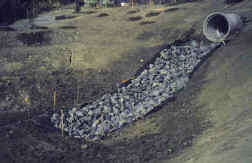 The Ponds serve many purposes other than just filtering surface run-off
water. Normally surface water will percolate underground where it
forms ground water, which serves our drinking water needs. The percolation
process helps filter out some of the harmful suspended solids in the water.
This can be performed by having the water go through a natural filter,
rocks, gravel, sand, and even charcoal. Each different layer of this
filter helps remove something different. The rocks and gravel will
trap and remove large particles of pollution such as plant debris and sediments.
The sand will remove smaller particles such as some types of metal.
This you can try at home or school as an experiment on how water can be
filtered. You need different types and sizes of rocks, sand, charcoal,
dirty water, and a plastic water bottle with holes at the bottom.
Fill and compact with dry rocks, sand, and charcoal; then add the dirty
water. This demonstrates the necessity of having different sizes
of rocks to line man-made water bodies, like the quarry ponds adjacent
to Paseo Padre Parkway. The picture on the left of the page shows
how water entering a water system can be filtered as it enters the water
system. Notice the different layers under the large rocks.
The Ponds serve many purposes other than just filtering surface run-off
water. Normally surface water will percolate underground where it
forms ground water, which serves our drinking water needs. The percolation
process helps filter out some of the harmful suspended solids in the water.
This can be performed by having the water go through a natural filter,
rocks, gravel, sand, and even charcoal. Each different layer of this
filter helps remove something different. The rocks and gravel will
trap and remove large particles of pollution such as plant debris and sediments.
The sand will remove smaller particles such as some types of metal.
This you can try at home or school as an experiment on how water can be
filtered. You need different types and sizes of rocks, sand, charcoal,
dirty water, and a plastic water bottle with holes at the bottom.
Fill and compact with dry rocks, sand, and charcoal; then add the dirty
water. This demonstrates the necessity of having different sizes
of rocks to line man-made water bodies, like the quarry ponds adjacent
to Paseo Padre Parkway. The picture on the left of the page shows
how water entering a water system can be filtered as it enters the water
system. Notice the different layers under the large rocks.
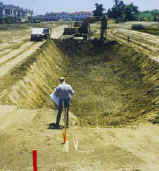 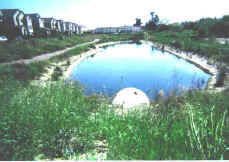 The
use of the entire channel to clean storm water is shown in the two pictures
on both sides. The one of the large trench is before the ponds where
graded with the rock to make it less steep to reduce the erosion of the
banks. The plants will line the upper portion of the pond and allow
the growth of other plants along the bottom. The second picture is
the same pond only it is filled and working properly. Notice the
difference in the area and how plant life returned. The
use of the entire channel to clean storm water is shown in the two pictures
on both sides. The one of the large trench is before the ponds where
graded with the rock to make it less steep to reduce the erosion of the
banks. The plants will line the upper portion of the pond and allow
the growth of other plants along the bottom. The second picture is
the same pond only it is filled and working properly. Notice the
difference in the area and how plant life returned.
The log boom in this picture is to skim the water
to trap floating debris and prevent it from continuing on to the bay and
obstructing any water ways. The boom also acts as a partial dam to
slow down the movement of the passing water. 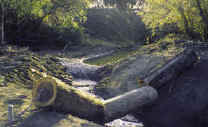
Currently the construction of an outdoor facility
is underway. The facility will be used to monitor pollutant levels
and also to conduct classroom experiments while on field trips. The
wildlife has returned and is thriving.
|



 The
water treatment ponds function on the slowing of the water to allow suspended
particles to drop out of the solution. This causes the water to become
less of a potential hazard later in the bay and even the ocean. The
suspended particles range from heavy metals; such as copper (Cu), Lead
(Pb) and Zinc (Zn), to simple things like soil. The heavy metals
can cause fish deaths and algae blooms that can harm the water's environment
for all living things, including making the water unusable for human recreation.
The soil can prevent the penetration of sunlight to the underwater organisms
that use the sunlight to produce nutrients necessary for the organisms
survival. Fertilizers will cause large growths of water plants which
can reduce the necessary amounts of nutrients to fish and other water organisms.
Motor oil will coat fish gills and kill the fish when it cannot breathe,
and it will coat birds wings and make them too heavy to fly away when a
predator is seen. These materials are hazardous to the animals both
in and out of the water as well as the plants in the surrounding waterway.
The
water treatment ponds function on the slowing of the water to allow suspended
particles to drop out of the solution. This causes the water to become
less of a potential hazard later in the bay and even the ocean. The
suspended particles range from heavy metals; such as copper (Cu), Lead
(Pb) and Zinc (Zn), to simple things like soil. The heavy metals
can cause fish deaths and algae blooms that can harm the water's environment
for all living things, including making the water unusable for human recreation.
The soil can prevent the penetration of sunlight to the underwater organisms
that use the sunlight to produce nutrients necessary for the organisms
survival. Fertilizers will cause large growths of water plants which
can reduce the necessary amounts of nutrients to fish and other water organisms.
Motor oil will coat fish gills and kill the fish when it cannot breathe,
and it will coat birds wings and make them too heavy to fly away when a
predator is seen. These materials are hazardous to the animals both
in and out of the water as well as the plants in the surrounding waterway.
 The Ponds serve many purposes other than just filtering surface run-off
water. Normally surface water will percolate underground where it
forms ground water, which serves our drinking water needs. The percolation
process helps filter out some of the harmful suspended solids in the water.
This can be performed by having the water go through a natural filter,
rocks, gravel, sand, and even charcoal. Each different layer of this
filter helps remove something different. The rocks and gravel will
trap and remove large particles of pollution such as plant debris and sediments.
The sand will remove smaller particles such as some types of metal.
This you can try at home or school as an experiment on how water can be
filtered. You need different types and sizes of rocks, sand, charcoal,
dirty water, and a plastic water bottle with holes at the bottom.
Fill and compact with dry rocks, sand, and charcoal; then add the dirty
water. This demonstrates the necessity of having different sizes
of rocks to line man-made water bodies, like the quarry ponds adjacent
to Paseo Padre Parkway. The picture on the left of the page shows
how water entering a water system can be filtered as it enters the water
system. Notice the different layers under the large rocks.
The Ponds serve many purposes other than just filtering surface run-off
water. Normally surface water will percolate underground where it
forms ground water, which serves our drinking water needs. The percolation
process helps filter out some of the harmful suspended solids in the water.
This can be performed by having the water go through a natural filter,
rocks, gravel, sand, and even charcoal. Each different layer of this
filter helps remove something different. The rocks and gravel will
trap and remove large particles of pollution such as plant debris and sediments.
The sand will remove smaller particles such as some types of metal.
This you can try at home or school as an experiment on how water can be
filtered. You need different types and sizes of rocks, sand, charcoal,
dirty water, and a plastic water bottle with holes at the bottom.
Fill and compact with dry rocks, sand, and charcoal; then add the dirty
water. This demonstrates the necessity of having different sizes
of rocks to line man-made water bodies, like the quarry ponds adjacent
to Paseo Padre Parkway. The picture on the left of the page shows
how water entering a water system can be filtered as it enters the water
system. Notice the different layers under the large rocks.

 The
use of the entire channel to clean storm water is shown in the two pictures
on both sides. The one of the large trench is before the ponds where
graded with the rock to make it less steep to reduce the erosion of the
banks. The plants will line the upper portion of the pond and allow
the growth of other plants along the bottom. The second picture is
the same pond only it is filled and working properly. Notice the
difference in the area and how plant life returned.
The
use of the entire channel to clean storm water is shown in the two pictures
on both sides. The one of the large trench is before the ponds where
graded with the rock to make it less steep to reduce the erosion of the
banks. The plants will line the upper portion of the pond and allow
the growth of other plants along the bottom. The second picture is
the same pond only it is filled and working properly. Notice the
difference in the area and how plant life returned.
